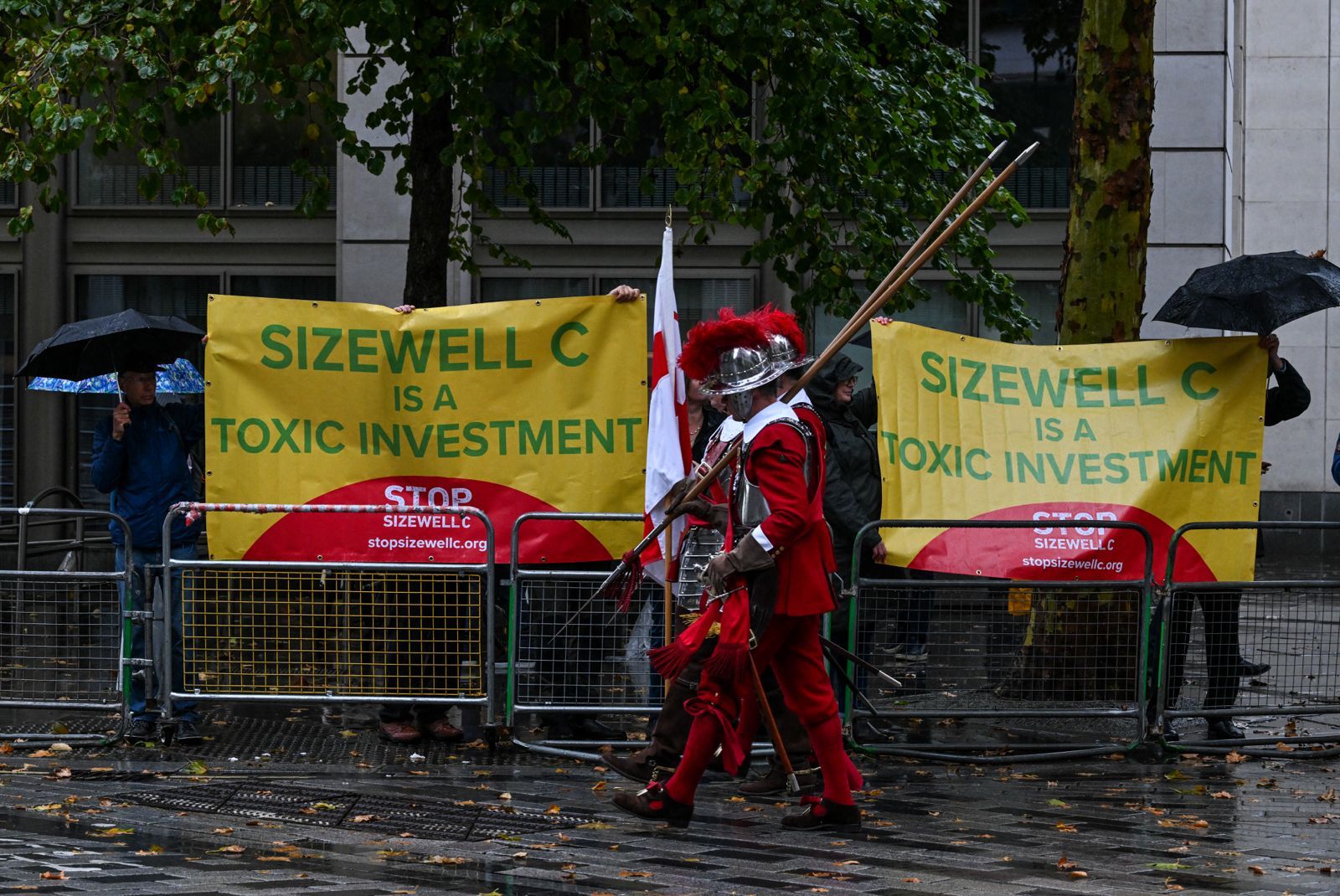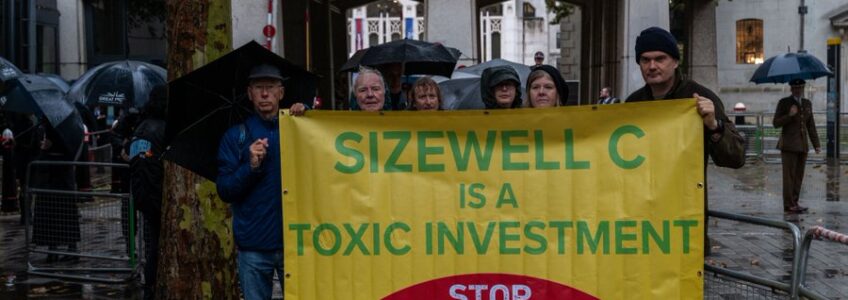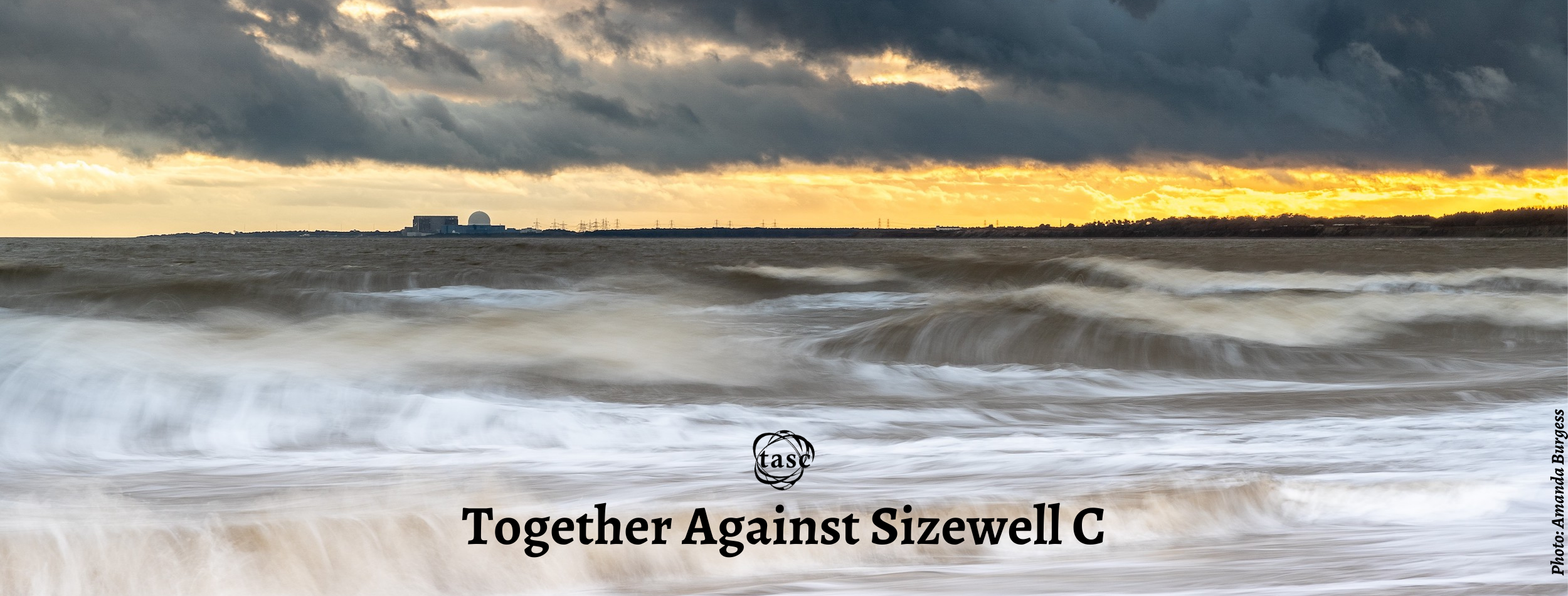
Campaigners welcome international investors to UK summit but urge them to boycott “toxic investment” Sizewell C
Ministers should exclude Sizewell C from their Industrial Strategy as it cannot help them achieve their Energy Mission
14 October 2024
For Immediate Release
[City of London] Campaigners opposed to Sizewell C unfurled two banners saying “Sizewell C is a Toxic Investment” this morning outside the City of London’s Guildhall. The protest took place as world business leaders gathered for Labour’s first International Investment Summit, and the Labour government launched its Industrial Strategy consultation. [1] A Sizewell C Final Investment Decision (FID) has been delayed [2] and rumours are swirling around about which, if any, of the small pool of private investors reported to be taking part in the equity raise are still involved.
Alison Downes of Stop Sizewell C said “It’s fantastic that Britain is open for business, but we’re here to tell international investors that, unless they want to find themselves embroiled in another HS2, they should put their money into renewables instead of slow, risky, expensive, “toxic” Sizewell C. The reality is that Sizewell C cannot help the Labour government achieve its Energy Mission, [3] and if UK investors won’t touch it, neither should international ones, nor the taxpayer.”
Chris Wilson of Together Against Sizewell C said “The UK is wooing overseas companies to back Sizewell C while EDF desperately struggles to find investors to complete Hinkley Point C, [4] but the fact is not a single EPR reactor has been built to time or budget anywhere in the world. The unreliability of this type of reactor when finally operational – such as at Taishan and Olkiluoto [5] – should deter international investors. But these issues should also make UK Ministers seriously reconsider how Sizewell C could possibly help energy security, let alone fix our climate crisis”
A confidential source has told Stop Sizewell C that there may only be a couple of investors remaining in the equity raise process but we’ve been unable to verify which, if any, of the previously named companies these might be, including:
-
Universities Superannuation Service (USS), but a Bloomberg report in August, that flagged FID delays, did not mention USS. [6]
-
Centrica. Chris O’Shea has publicly stated his interest in Sizewell C but on 10 October The Guardian reported that Centrica may be interested in investing in Hinkley Point C or Sizewell C, but not both. [see 4]
-
Emirates Nuclear Energy Corporation (ENEC). Relations between the UK and UAE have been chilly at times in the last year, and the UAE gave a red carpet welcome to Vladimir Putin during COP. [7]
-
Equitix Infrastructure. Like USS, Bloomberg did not name Equitix. [see 6]
-
Amber Infrastructure and Schroders Greencoat, neither of which was expected to take a significant stake.
Notes
3. Labour’s mission is to ‘make Britain a clean energy superpower to cut bills, create jobs and deliver security with cheaper, zero-carbon electricity by 2030, accelerating to net zero’. See below for a summary of how Sizewell C cannot help the government achieve this.
Labour’s mission is to ‘make Britain a clean energy superpower to cut bills, create jobs and deliver security with cheaper, zero-carbon electricity by 2030, accelerating to net zero’. With respect to these objectives and Sizewell C
-
Not Clean: Nuclear waste means nuclear is neither clean nor green.
-
Cut Bills. Sizewell C would increase bills from the day of a Final Investment Decision through the Regulated Asset Base. Households have no means to mitigate their share of the risk of overruns and overspends in an inherently risky project. Sizewell C is capital intensive, and interest from private investors is reported to be low. The last government was
reported to be considering taking a majority stake in construction, meaning a significant drain on public funding at the expense of other priorities. With Labour’s £22 billion hole, Sizewell C should be axed. Attempts to draw in more private investment will increase the rate of return demanded and further undermine an already suspect Value for Money case.
-
Create Jobs: The number of long-term jobs at Sizewell C is relatively small for the cost of construction, and the construction period will cause damage to the existing local economy.
-
Deliver Security: The track record of constructing EPR reactors is exceedingly poor, as evidenced by all previous constructions,
especially Hinkley Point C. The case for replication reducing overruns and overspends is dubious; the Sizewell C site has been described by an ONR Inspector privately as “expensive to develop compared to Hinkley C” and hypothesised that savings would be absorbed in complex groundworks. Delays mean there are no guarantees workers with experience at Hinkley Point C would be available for Sizewell C.
-
-
Sizewell C’s contribution to the UK’s energy security is compromised by concerns about the reactor performance, its reliance on French state-owned EDF and potentially on the UAE state owned ENEC for funding.
-
Cheaper Electricity: The “Allowed Revenue” Sizewell C would be permitted to receive under the RAB model will make it a more expensive source of electricity than that which would otherwise be available to consumers from renewable sources.
-
Net zero by 2030. Sizewell C cannot contribute to 2030 (EDF says it will take 10-12 years, analysis by the last government found 13-17 years on average). The 2030 target must therefore be achieved by other means. Scaling up this 2030 system, alongside energy efficiency provides an alternative to proceeding with Sizewell C.
Oxford University’s Smith School said “we could power not just the entire electricity system but the whole energy system of this country with wind and solar” Other studies support this and challenge claims Sizewell C would reduce systems costs.*
For more information contact:
Alison Downes, Stop Sizewell C, 07711 843884
Chris Wilson, Together Against Sizewell C, 07976 820524



